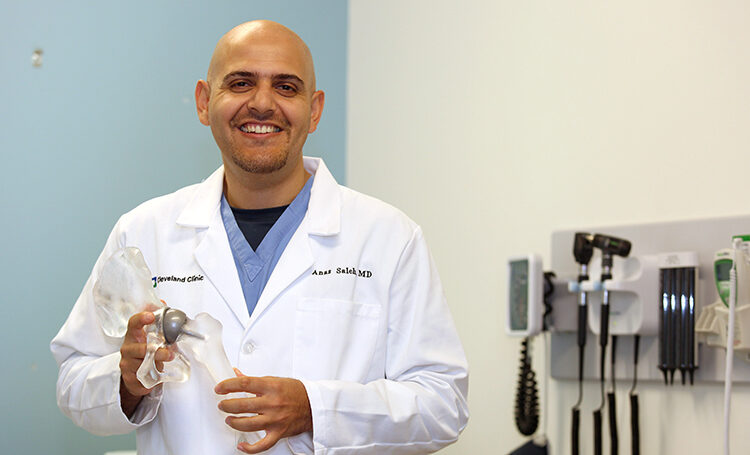
If you have a hip – or hips – that have become painful and are limiting your activity, you may be thinking of having a hip replacement operation, and that might be the best solution, too. But there is another option for some patients – hip resurfacing.
Hip resurfacing consists of placing a cap – made of cobalt-chrome metal and shaped like a hollow mushroom – over the head of the femur while a matching metal cup is placed in the pelvis socket, replacing the articulating surfaces of the hip joint while removing very little bone compared to a total hip replacement.
“Cleveland Clinic is the largest resurfacing clinic in the world,” said Dr. Anas Saleh, an orthopedic surgeon at Cleveland Clinic Indian River Hospital who is one of a select group of physicians proficient at the procedure.
“A total hip replacement has a socket and ball component to it which articulates with the socket, but it also has a long stem that goes into the thigh bone. Resurfacing also has a socket, but instead of having a ball and stem, it’s actually a metal cap.
The difference between total replacement and resurfacing is like the difference between putting a hat on your head or cutting it off. The procedure is more precise and less forgiving, so you really need a surgeon who has done the resurfacing multiple times. Frequency is the key to expertise.
“Resurfacing is really best suited for younger males with strong bones,” Dr. Saleh continued.
“Because we are putting a cap on the femoral head instead of cutting off, we are preserving the bone and it actually solves some of the issues we have with a traditional total hip replacement.
It eliminates the risk for both dislocation and limb length discrepancy. With resurfacing you really don’t change the length at all. Many high-profile athletes have opted for hip resurfacing because it allows for unrestricted activity and they can go back to high impact sports.”
Hip resurfacing is seldom done on females because there is a higher risk of complication with smaller implant size, and, on average, female joints are smaller than male ones. There are companies working on ceramic resurfacings that will be more suited for females.
Mayo Clinic identifies three major sources of hip joint pain – osteoarthritis, rheumatoid arthritis and osteonecrosis.
Osteoarthritis, also known as wear-and-tear arthritis, causes damage to the cartilage covering the ends of the bones, which prevents the joints from moving smoothly and inhibits activity.
Rheumatoid arthritis, caused by an overactive immune system, causes inflammation that can erode cartilage and underlying bone, resulting in damaged and deformed joints.
Osteonecrosis is a condition where there isn’t enough blood supplied to the ball portion of the hip joint; it can also occur in a dislocation or fracture that causes the bone to collapse or deform resulting in painful hip joints.
Happily, hip surgeries are among the most successful orthopedic procedures and can dramatically improve the quality of life for someone living with hip pain.
The success rates for hip replacement surgery and hip resurfacing are high, with about 95 percent of patients experiencing relief from hip pain. The success rate of hip replacements 10 years after surgery is 90-to-95 percent and at 20 years 80-to-85 percent. Should an implant wear or loosen, revision to a new hip replacement is possible.
“Total hip and resurfacing metal components last almost forever once they grow into the bone, so any adjustments would be made to the bearing surface. The newer generation ceramic on polyethylene implants can last up to 30 years,” Dr. Saleh said.
Recovery from hip replacement or resurfacing is fairly easy. The wound takes about two weeks to heal, and most people are driving by three weeks and functioning well within four to six weeks. Those with sedentary jobs are back to work between three to six weeks, but those with more labor-intensive jobs may take up to two to three months to be at full capacity.
“Hip replacement is an elective operation and it’s ultimately up to the patient to decide if they can live with the pain,” said Dr. Saleh. “The pain won’t kill them, but it can lead to functional decline, pulmonary complications and overall deterioration in health. While the risk is minimal … the benefit of being ambulatory can drastically improve physical and mental well-being.”
A consultation with an orthopedic surgeon can identify the treatments or procedures that are best for eliminating your hip joint pain. Most doctors will advise starting with anti-inflammatory medications like Aleve and Motrin, followed by injections of cortisone. In addition, there are gel-like injections that act as synovial fluid and help facilitate movement and reduce pain.
Once those treatments are exhausted and no longer effective, the surgeon will discuss hip replacement or resurfacing. Treatments selected depend on the severity of the joint deterioration and the patient’s overall health.
Dr. Anas Saleh is from Qatar in Eastern Arabia. He was educated at the Weill Cornell Medical College in Qatar and completed his residency in Orthopedic Surgery at Cleveland Clinic Foundation in Ohio. After finishing his fellowship at Rush University Medical College in Illinois, he joined the Cleveland Clinic Indian River Hospital team in Vero Beach. He can be reached at 877-463-2010.



